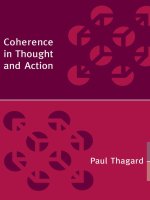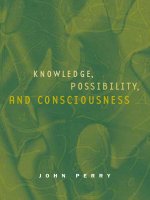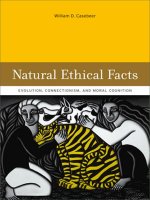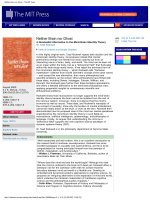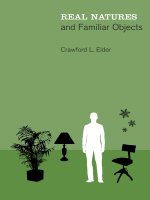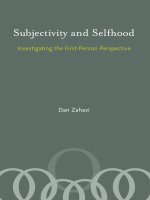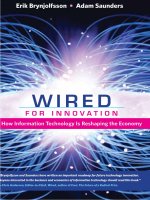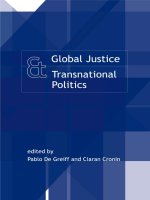the mit press quantum computing without magic devices sep 2008
Bạn đang xem bản rút gọn của tài liệu. Xem và tải ngay bản đầy đủ của tài liệu tại đây (8.16 MB, 445 trang )
Quantum Computing without Magic
Scientific and Engineering Computation
William Gropp and Ewing Lusk, editors; Janusz Kowalik, founding editor
Unstructured Scientific Computation on Scalable Multiprocessors, edited by Piyush Mehrotra,
Joel Saltz, and Robert Voigt, 1992
Parallel Computational Fluid Dynamics: Implementation and Results, edited by Horst
D. Simon, 1992
The High Performance Fortran Handbook, Charles H. Koelbel, David B. Loveman, Robert
S. Schreiber, Guy L. Steele Jr., and Mary E. Zosel, 1994
PVM: Parallel Virtual Machine–A Users’ Guide and Tutorial for Network Parallel Computing,
Al Geist, Adam Beguelin, Jack Dongarra, Weicheng Jiang, Bob Manchek, and Vaidy Sunderam,
1994
Practical Parallel Programming, Gregory V. Wilson, 1995
Enabling Technologies for Petaflops Computing, Thomas Sterling, Paul Messina, and Paul
H. Smith, 1995
An Introduction to High-Performance Scientific Computing, Lloyd D. Fosdick, Elizabeth
R. Jessup, Carolyn J. C. Schauble, and Gitta Domik, 1995
Parallel Programming Using C++, edited by Gregory V. Wilson and Paul Lu, 1996
Using PLAPACK: Parallel Linear Algebra Package, Robert A. van de Geijn, 1997
Fortran 95 Handbook, Jeanne C. Adams, Walter S. Brainerd, Jeanne T. Martin, Brian T. Smith,
and Jerrold L. Wagener, 1997
MPI—The Complete Reference: Volume 1, The MPI Core, Marc Snir, Steve Otto, Steven
Huss-Lederman, David Walker, and Jack Dongarra, 1998
MPI—The Complete Reference: Volume 2, The MPI-2 Extensions, William Gropp, Steven
Huss-Lederman, Andrew Lumsdaine, Ewing Lusk, Bill Nitzberg, William Saphir, and Marc Snir,
1998
A Programmer’s Guide to ZPL, Lawrence Snyder, 1999
How to Build a Beowulf, Thomas L. Sterling, John Salmon, Donald J. Becker, and Daniel
F. Savarese, 1999
Using MPI: Portable Parallel Programming with the Message-Passing Interface,
second
edition
, William Gropp, Ewing Lusk, and Anthony Skjellum, 1999
Using MPI-2: Advanced Features of the Message-Passing Interface, William Gropp, Ewing
Lusk, and Rajeev Thakur, 1999
Beowulf Cluster Computing with Linux, second edition, William Gropp, Ewing Lusk, and
Thomas Sterling, 2003
Beowulf Cluster Computing with Windows, Thomas Sterling, 2001
Scalable Input/Output: Achieving System Balance, Daniel A. Reed, 2003
Using OpenMP: Portable Shared Memory Parallel Programming, Barbara Chapman, Gabriele
Jost, and Ruud van der Pas, 2008
Quantum Computing without Magic
Devices
Zdzislaw Meglicki
The MIT Press
Cambridge, Massachusetts
London, England
c
2008 Massachusetts Institute of Technology
All rights reserved. No part of this book may be reproduced in any form by any electronic or
mechanical means (including photocopying, recording, or information storage and retrieval)
without permission in writing from the publisher.
MIT Press books may be purchased at special quantity discounts for business or sales
promotional use. For information, please email special
or write to
Special Sales Department, The MIT Press, 55 Hayward Street, Cambridge, MA 02142.
This book was set in L
A
T
E
X by the author and was printed and bound in the United States of
America.
Library of Congress Cataloging-in-Publication Data
Meglicki, Zdzislaw, 1953–
Quantum computing without magic : devices / Zdzislaw Meglicki.
p. cm. — (Scientific and engineering computation)
Includes bibliographical references and index.
ISBN 978-0-262-13506-1 (pbk. : alk. paper)
1. Quantum computers. I. Title.
QA76.889.M44 2008
004.1—dc22
2008017033
10987654321
Dedicated to my cats, Bambosz and Sofa, who have a bone to pick with
Dr Schr¨odinger.
Contents
Series Foreword xi
Preface xiii
1 Bits and Registers 1
1.1 Physical Embodiments of a Bit 1
1.2 Registers 4
1.3 Fluctuating Registers 8
1.4 Mixtures and Pure States 13
1.5 Basis States 19
1.6 Functions and Measurements on Mixtures 21
1.7 Forms and Vectors 28
1.8 Transformations of Mixtures 32
1.9 Composite Systems 37
2 The Qubit 41
2.1 The Evil Quanta 41
2.2 The Fiducial Vector of a Qubit 47
2.3 The Stern-Gerlach Experiment 49
2.4 Polarized States 55
2.5 Mixtures of Qubit States 59
2.6 The Measurement 62
2.7 Pauli Vectors and Pauli Forms 65
2.8 The Hamiltonian Form 69
2.9 Qubit Evolution 72
2.10 Larmor Precession 75
2.11 Rabi Oscillations 78
2.11.1 Solution at Resonance 80
2.11.2 Solution off Resonance 85
2.12 The Quantronium 86
viii Contents
3 Quaternions 95
3.1 Continuing Development of Quantum Mechanics 95
3.2 Hamilton Quaternions 96
3.3 Pauli Quaternions 97
3.4 From Fiducial Vectors to Quaternions 99
3.5 Expectation Values 100
3.6 Mixtures 103
3.7 Qubit Evolution 104
3.8 Why Does It Work? 107
4 The Unitary Formalism 111
4.1 Unpacking Pauli Quaternions 111
4.2 Pauli Matrices 111
4.3 The Basis Vectors and the Hilbert Space 117
4.4 The Superstition of Superposition 121
4.5 Probability Amplitudes 130
4.6 Spinors 134
4.7 Operators and Operands 142
4.8 Properties of the Density Operator 148
4.9 Schr¨odinger Equation 151
4.9.1 General Solution of the Schr¨odinger Equation 153
4.9.2 Larmor Precession Revisited 160
4.10 Single Qubit Gates 162
4.11 Taking Qubits for a Ride 168
4.11.1 Dragging a Qubit along an Arbitrary Trajectory 169
4.11.2 Closed Trajectory Case 174
4.11.3 A Qubit in the Rotating Magnetic Field 177
4.11.4 Observing the Berry Phase Experimentally 183
4.11.5 Berry Phase Gates 187
Contents ix
5 The Biqubit 191
5.1 Entangled States 191
5.2 Pauli Exclusion Principle 204
5.3 A Superconducting Biqubit 206
5.4 An Atom and a Photon 216
5.5 A Biqubit in a Rotated Frame 219
5.6 Bell Inequality 224
5.7 Nonlocality 230
5.8 Single-Qubit Expectation Values 233
5.9 Classification of Biqubit States 236
5.10 Separability 247
5.11 Impure Quantum Mechanics 259
5.11.1 Nonunitary Evolution 262
5.11.2 Depolarization 266
5.11.3 Dephasing 270
5.11.4 Spontaneous Emission 273
5.12 Schr¨odinger’s Cat 277
5.12.1 The Haroche-Ramsey Experiment 279
6 The Controlled not Gate 289
6.1 The Quintessence of Quantum Computing 289
6.2 Universal Gates 292
6.2.1 The ABC Decomposition and Controlled-U 292
6.2.2 General Biqubit Unitary Gates 296
6.2.3 Triqubit Gates 303
6.2.4 Universality of the Deutsch Gate 306
6.3 The Cirac-Zoller Gate 322
6.4 The Superconducting Gate 333
x Contents
7 Yes, It Can Be Done with Cogwheels 343
7.1 The Deutsch Oracle 343
7.2 NMR Computing 352
7.3 Brassard Teleportation Circuit 362
7.4 The Grover Search Algorithm 371
7.5 Cogwheels 376
7.6 The Crossroad 387
A Quaternions and Pauli Matrices 393
A.1 Hamilton Quaternions 393
A.2 Pauli Quaternions 393
A.3 Pauli Matrices 395
B Biqubit Probability Matrices 397
C Tensor Products of Pauli Matrices 399
References 403
Index 417
Series Foreword
The Scientific and Engineering Series from MIT Press presents accessible accounts
of computing research areas normally presented in research papers and specialized
conferences. Elements of modern computing that have appeared thus far in the
Series include parallelism, language design and implementation, systems software,
and numerical libraries. The scope of the Series continues to expand with the spread
of ideas from computing into new aspects of science.
One of the most revolutionary developments in computing is the discovery of
algorithms for machines based not on operations on bits but on quantum states.
These algorithms make possible efficient solutions to problems, such as factoring
large numbers, currently thought to be intractable on conventional computers. But
how do these machines work, and how might they be built?
This book presents in a down-to-earth way the concepts of quantum computing
and describes a long-term plan to enlist the amazing—and almost unbelievable—
concepts of quantum physics in the design and construction of a class of computer
of unprecedented power. The engineering required to build such computers is in
an early stage, but in this book the reader will find an engaging account of the
necessary theory and the experiments that confirm the theory. Along the way the
reader will be introduced to many of the most interesting results of modern physics.
William Gropp and Ewing Lusk, Editors
Preface
This book arose from my occasional discussions on matters related to quantum
computing with my students and, even more so, with some of my quite distinguished
colleagues, who, having arrived at this juncture from various directions, would
at times reveal an almost disarming lack of understanding of quantum physics
fundamentals, while certainly possessing a formidable aptitude for skillfully juggling
mathematics of quantum mechanics and therefore also of quantum computing—
a dangerous combination. This lack of understanding sometimes led to perhaps
unrealistic expectations and, on other occasions, even to research suggestions that
were, well, unphysical.
Yet, as I discovered in due course, their occasionally pointed questions were very
good questions indeed, and their occasional disbelief was well enough founded, and
so, in looking for the right answers to them I was myself forced to revise my often
canonical views on these matters.
From the perspective of a natural scientist, the most rewarding aspect of quantum
computing is that it has reopened many of the issues that had been swept under
the carpet and relegated to the dustbin of history back in the days when quantum
mechanics had finally solidified and troublemakers such as Einstein, Schr¨odinger,
and Bohm were told in no uncertain terms to “put up or shut up.” And so, the
currently celebrated Einstein Podolsky Rosen paradox [38] lingered in the dustbin,
not even mentioned in the Feynman’s Lectures on Physics [42] (which used to be
my personal bible for years and years), until John Stewart Bell showed that it could
be examined experimentally [7].
Look what the cat dragged in!
When Aspect measurements [4] eventually confirmed that quantum physics was
indeed “nonlocal,” and not just on a microscopic scale, but over large macroscopic
distances even, some called it the “greatest crisis in the history of modern physics.”
Why should it be so? Newtonian theory of gravity is nonlocal, too, and we have
been living with it happily since its conception in 1687. On the other hand, others
spotted an opportunity in the crisis. “This looks like fun,” they said. “What can
we do with it?” And this is how quantum computing was born. An avalanche of
ideas and money that has since tumbled into physics laboratories has paid for many
wonderful experiments and much insightful theoretical work.
But some of the money flowed into departments of mathematics, computer sci-
ence, chemistry, and electronic engineering, and it is for these somewhat bewildered
colleagues of mine that I have written this book. Its basic purpose is to explain
how quantum differs from “classical,” how quantum devices are supposed to work,
and even why and how the apparatus of quantum mechanics comes into being. If
xiv Preface
this text were compared to texts covering classical computing, it would be a text
about the most basic classical computing devices: diodes, transistors, gates. Such
books are well known to people who are called electronic device engineers. Quantum
Computing without Magic is a primer for future quantum device engineers.
In classical digital computing everything, however complex or sophisticated, can
be ultimately reduced to Boolean logic and nand or nor gates. So, once we know
how to build a nand or a nor gate, all else is a matter of just connecting enough of
these gates to form such circuitry as is required. This, of course, is a simplification
that omits power conditioning and managing issues, and mechanical issues—after
all, disk drives rotate, have bearings and motors, as do cooling fans; and then we
have keyboards, mice, displays, cameras, and so on. But the very heart of it all
is Boolean logic and simple gates. Yet, the gates are no longer this simple when
their functioning is scrutinized in more detail. One could write volumes about gates
alone.
Quantum computing, on the other hand, has barely progressed beyond a single
gate concept in practical terms. Although numerous learned papers exist that con-
template large and nontrivial algorithms, the most advanced quantum computers
of 2003 comprised mere two “qubits” and performed a single gate computation.
And, as of early 2007, there hasn’t been much progress. Quantum computing is
extremely hard to do. Why? This is one of the questions this book seeks to answer.
Although Quantum Computing without Magic is a simple and basic text about
qubits and quantum gates, it is not a “kindergarten” text. The readers are assumed
to have mathematical skills befitting electronic engineers, chemists, and, certainly,
mathematicians. The readers are also assumed to know enough basic quantum
physics to not be surprised by concepts such as energy levels, Josephson junctions,
and tunneling. After all, even entry-level students nowadays possess considerable
reservoirs of common knowledge—if not always very detailed—about a great many
things, including the world of quantum physics and enough mathematics to get by.
On the other hand, the text attempts to explain everything in sufficient detail
to avoid unnecessary magic—including detailed derivations of various formulas,
that may appear tedious to a professional physicist but that should help a less
experienced reader understand how they come about. In the spirit of stripping
quantum computing of magic, we do not leave such results to exercises.
For these reasons, an adventurous teacher might even risk complementing an
introductory course in quantum mechanics with selected ideas and materials derived
from this text. The fashionable subject of quantum computing could serve here as
an added incentive for students to become acquainted with many important and
interesting concepts of quantum physics that traditionally have been either put on
Preface xv
the back burner or restricted to more advanced classes. The familiarity gained with
the density operator theory at this early stage, as well as a good understanding of
what is actually being measured in quantum physics and how, can serve students
well in their future careers.
Quantum mechanics is a probability theory. Although this fact is well known
to physicists, it is often swept under the carpet or treated as somehow incidental.
I have even heard it asked, “Where do quantum probabilities come from?”—as if
this question could be answered by unitary manipulations similar to those invoked
to explain decoherence. In the days of my youth a common opinion prevailed that
quantum phenomena could not be described in terms of probabilities alone and that
quantum mechanics itself could not be formulated in a way that would not require
use of complex numbers. Like other lore surrounding quantum mechanics this
opinion also proved untrue, although it did not become clear until 2000, when Stefan
Weigert showed that every quantum system and its dynamics could be characterized
fully in terms of nonredundant probabilities [145]. Even this important theoretical
discovery was not paid much attention until Lucien Hardy showed a year later
that quantum mechanics of discrete systems could be derived from “five reasonable
axioms” all expressed in terms of pure theory of probability [60].
Why should it matter? Isn’t it just a question of semantics? I think it matters
if one is to understand where the power of quantum mechanics as a theory derives
from. It also matters in terms of expectations. Clearly, one cannot reasonably
expect that a theory of probability can explain the source of probability, if such
exists at all—which is by no means certain in quantum physics, where probabilities
may be fundamental.
This book takes probability as a starting point. In Chapter 1 we discuss classical
bits and classical registers. We look at how they are implemented in present-day
computers. Then we look at randomly fluctuating classical registers and use this
example to develop the basic formalism of probability theory. It is here that we
introduce concepts of fiducial states, mixed and pure states, linear forms repre-
senting measurements, combined systems, dimensionality, and degrees of freedom.
Hardy’s theorem that combines the last two concepts is discussed as well, as it ex-
presses most succinctly the difference between classical and quantum physics. This
chapter also serves as a place where we introduce basic linear algebra, taking care
to distinguish between vectors and forms, and introducing the concept of tensor
product.
We then use this apparatus in Chapter 2, where we introduce a qubit. We de-
scribe it in terms of its fiducial vector and show how the respective probabilities
can be measured by using the classical Stern-Gerlach example. We show a dif-
xvi Preface
ference between fully polarized and mixed states and demonstrate how an act of
measurement breaks an initial pure state of the beam, converting it to a mixture.
Eventually we arrive at the Bloch ball representation of qubit states. Then we
introduce new concepts of Pauli vectors and forms. These will eventually map onto
Pauli matrices two chapters later. But at this stage they will help us formulate
laws of qubit dynamics in terms of pure probabilities—following Hardy, we call this
simple calculus the fiducial formalism. It is valuable because it expresses qubit
dynamics entirely in terms of directly measurable quantities. Here we discuss in
detail Larmor precession, Rabi oscillations, and Ramsey fringes—these being fun-
damental to the manipulation of qubits and quantum computing in general. We
close this chapter with a detailed discussion of quantronium, a superconducting
circuit presented in 2002 by Vion, Aassime, Cottet, Joyez, Pothier, Urbina, Esteve,
and Devoret, that implemented and demonstrated the qubit [142].
Chapter 3 is short but pivotal to our exposition. Here we introduce quater-
nions and demonstrate a simple and natural mapping between the qubit’s fiducial
representation and quaternions. In this chapter we encounter the von Neumann
equation, as well as the legendary trace formula, which turns out to be the same
as taking the arithmetic mean over the statistical ensemble of the qubit. We learn
to manipulate quaternions by the means of commutation relations and discover the
sole source of their power: they capture simultaneously in a single formula the cross
and the dot products of two vectors. The quaternion formalism is, in a nutshell, the
density operator theory. It appears here well before the wave function and follows
naturally from the qubit’s probabilistic description.
Chapter 4 continues the story, beginning with a search for a simplest matrix
representation of quaternions, which yields Pauli matrices. We then build the
Hilbert space, which the quaternions, represented by Pauli matrices, act on and
discover within it the images of the basis states of the qubit we saw in Chapter 2. We
discover the notion of state superposition and derive the probabilistic interpretation
of transition amplitudes. We also look at the transformation properties of spinors,
something that will come handy when we get to contemplate Bell inequalities in
Chapter 5. We rephrase the properties of the density operator in the unitary
language and then seek the unitary equivalent of the quaternion von Neumann
equation, which is how we arrive at the Schr¨odinger equation. We study its general
solution and revisit and reinterpret the phenomenon of Larmor precession. We
investigate single qubit gates, a topic that leads to the discussion of Berry phase
[12], which is further illustrated by the beautiful 1988 experiment of Richardson,
Kilvington, Green, and Lamoreaux [119].
In Chapter 5 we encounter the simplest bipartite quantum system, the biqubit.
Preface xvii
We introduce the reader to the notion of entanglement and then illustrate it with
experimental examples. We strike while the iron is hot; otherwise who would believe
such weirdness to be possible? We begin by showing a Josephson junction biqubit
made by Berkley, Ramos, Gubrud, Strauch, Johnson, Anderson, Dragt, Lobb, and
Wellstood in 2003 [11]. Then we show an even more sophisticated Josephson junc-
tion biqubit made in 2006 by Steffen, Ansmann, Bialczak, Katz, Lucero, cDermott,
Neeley, Weig, Cleland, and Martinis [134]. In case the reader is still not convinced
by the functioning of these quantum microelectronic devices, we discuss a very clean
example of entanglement between an ion and a photon that was demonstrated by
Blinov, Moehring, Duan, and Monroe in 2004 [13]. Having (we hope) convinced
the reader that an entangled biqubit is not the stuff of fairy tales, we discuss its
representation in a rotated frame and arrive at Bell inequalities. We discuss their
philosophical implications and possible ontological solutions to the puzzle at some
length before investigating yet another feature of a biqubit—its single qubit expec-
tation values, which are produced by partial traces. This topic is followed by a quite
detailed classification of biqubit states, based on Englert and Metwally [39], and
discussion of biqubit separability that is based on the Peres-Horodeckis criterion
[113, 66].
Mathematics of biqubits is a natural place to discuss nonunitary evolution and to
present simple models of important nonunitary phenomena such as depolarization,
dephasing, and spontaneous emission. To a future quantum device engineer, these
are of fundamental importance, inasmuch as every classical device engineer must
have a firm grasp of thermodynamics. One cannot possibly design a working engine,
or a working computer, while ignoring the fundamental issue of heat generation and
dissipation. Similarly, one cannot possibly contemplate designing working quantum
devices while ignoring the inevitable loss of unitarity in every realistic quantum
process.
We close this chapter with the discussion of the Schr¨odinger cat paradox and a
beautiful 1996 experiment of Brune, Hagley, Dreyer, Maitre, Maali, Wunderlich,
Raimond, and Haroche [18]. This experiment clarifies the muddled notion of what
constitutes a quantum measurement and, at the same time, is strikingly “quantum
computational” in its concepts and methodology.
The last major chapter of the book, Chapter 6. puts together all the physics and
mathematics developed in the previous chapters to strike at the heart of quantum
computing: the controlled-not gate. We discuss here the notion of quantum gate
universality and demonstrate, following Deutsch [29], Khaneja and Glaser [78], and
Vidal and Dawson [140], that the controlled-not gate is universal for quantum
computation. Then we look closely at the Cirac-Zoller idea of 1995 [22] and its
xviii Preface
elegant 2003 implementation by Schmidt-Kaler, H¨affner, Riebe, Gulde, Lancaster,
Deuschle, Bechner, Roos, Eschner, and Blatt [125]. On this occasion we also discuss
the functioning of the linear Paul trap, electron shelving technique, laser cooling,
and side-band transitions, which are all crucial in this experiment. We also look at
the 2007 superconducting controlled-not gate developed by Plantenberg, de Groot,
Harmans, and Mooij [114] and at the 2003 all-optical controlled-not gate demon-
strated by O’Brien, Pryde, White, Ralph, and Branning [101].
In the closing chapter of the book we outline a roadmap for readers who wish to
learn more about quantum computing and, more generally, about quantum infor-
mation theory. Various quantum computing algorithms as well as error correction
procedures are discussed in numerous texts that have been published as far back as
2000, many of them “classic.” The device physics background provided by this book
should be sufficient to let its readers follow the subject and even read professional
publications in technical journals.
But there is another aspect of the story we draw the reader’s attention to in this
chapter. How “quantum” is quantum computing? Is “quantum” really so unique
and different that it cannot be faked at all by classical systems? When compar-
isons are made between quantum and classical algorithms and statements are made
along the lines that “no classical algorithm can possibly do this,” the authors,
rather narrow-mindedly, restrict themselves to comparisons with classical digital
algorithms. But the principle of superposition, which makes it possible for quan-
tum algorithms to attain exponential speedup, is not limited to quantum physics
only. The famous Grover search algorithm can be implemented on a classical analog
computer, as Grover himself demonstrated together with Sengupta in 2002 [57]. It
turns out that a great many features of quantum computers can be implemented
by using classical analog systems, even entanglement [24, 133, 103, 104, 105]. For
a device engineer this is a profound revelation. Classical analog systems are far
easier to construct and operate than are quantum systems. If similar computa-
tional efficiencies can be attained this way, may not this be an equally profitable
endeavor? We don’t know the full answer to this question, perhaps because it has
not been pursued with as much vigor as has quantum computing itself. But it is
an interesting fundamental question in its own right, even from a natural scientist’s
point of view.
Throughout the whole text and in all quoted examples, I have continuously made
the point that everything in quantum physics is about probabilities. A single de-
tection is meaningless and useless, even in those rare situations when theoretical
reasoning lets us reduce a problem’s solution to such. Experimental realities ensure
that we must repeat our detection many times to provide us with classical, not
Preface xix
necessarily quantum, error estimates. When a full characterization of a quantum
state is needed, the whole statistical ensemble that represents the state must be
explored. After all, what is a “quantum state” if not an abstraction that refers to
the vector of probabilities that characterize it [60]? And there is but one way to
arrive at this characterization. One has to measure and record sometimes hundreds
of thousands of detections in order to estimate the probabilities with such error as
the context requires.
And don’t you ever forget it!
This, of course, does have some bearing on the cost and efficiency of quantum
computation, even if we were to overlook quantum computation’s energetic ineffi-
ciency [49], need for extraordinary cooling and isolation techniques, great complex-
ity and slowness of multiqubit gates, and numerous other problems that all derive
from physics. This is where quantum computing gets stripped of its magic and
dressed in the cloak of reality. But this is not a drab cloak. It has all the coarseness
and rich texture of wholemeal bread, and wholemeal bread is good for you.
Acknowledgments
This book owes its existence to many people who contributed to it in various ways,
often unknowingly, over the years. But in the first place I would like to thank the
editors for their forbearance and encouragement, and to Gail Pieper, who patiently
read the whole text herself and through unquestionable magic of her craft made it
readable for others.
To Mike McRobbie of Indiana University I owe the very idea that a book could be
made of my early lecture notes, and the means and opportunity to do so. Eventually,
little of my early notes made it into the book, which is perhaps for the better.
I owe much inspiration, insights and help to my professional colleagues, Zhenghan
Wang, Lucien Hardy, Steven Girvin, and Mohammad Amin, whose comments, sug-
gestions, ideas, and questions helped me steer this text into what it has eventually
become.
My interest in the foundations of quantum mechanics was awoken many years
ago by Asher Peres, who visited my alma mater briefly and talked about the field,
and by two of my professors Bogdan Mielnik and Iwo Birula-Bialynicki. Although
I understood little of it at the time, I learned that the matter was profound and by
no means fully resolved. It was also immensely interesting.
To my colleagues and friends at the University of Western Australia, Arme-
nag Nassibian, Laurie Faraone, Paul McCormick, Armando Scolaro, Zig Budrikis,
and Yianni Attikiouzel, I owe my electronic engineering background and common
xx Preface
sense that, ultimately, helped me navigate through the murky waters of quantum
computing and quantum device engineering.
To my many colleagues and friends at the Australian National University, among
them Bob Maier, John Slaney, Bob Dewar, Dayal Wickramasighe, and Bob Gingold,
I owe my return to physics and deeper interest in computing, as well as countless
hours of discussions on completely unrelated topics, though enjoyable nevertheless.
And to my cats, who did all they could to stop me from writing this book, I owe
it that they gave up in the end.
Quantum Computing without Magic
“If you want to amount to anything as a witch,
Magrat Garlick, you got to learn three things.
What’s real, what’s not real, and what’s the
difference—”
Terry Pratchett, Witches Abroad
1 Bits and Registers
1.1 Physical Embodiments of a Bit
Information technology devices, such as desktop computers, laptops, palmtops, Bits and bytes
cellular phones, and DVD players, have pervaded our everyday life to such extent
that it is difficult to find a person who would not have at least some idea about
what bits and bytes are. I shall assume therefore that the reader knows about both,
enough to understand that a bit is the “smallest indivisible chunk of information”
and that a byte is a string of eight bits.
Yet the concept of a bit as the smallest indivisible chunk of information is a Discretization of
information is a
convention.
somewhat stifling convention. It is possible to dose information in any quantity,
not necessarily in discrete chunks, and this is how many analog devices, including
analog computers, work. What’s more, it takes a considerable amount of signal
processing, and consequently also power and time, to maintain a nice rectangular
shape of pulses representing bits in digital circuits. Electronic circuits that can
handle information directly, without chopping it to bits and arranging it into bytes,
can be orders of magnitude faster and more energy efficient than digital circuits.
How are bits and bytes actually stored, moved, and processed inside digital de- Storing and
manipulating
bits
vices? There are many ways to do so. Figure 1.1 shows a logic diagram of one of
the simplest memory cells, a flip-flop.
The flip-flop in Figure 1.1 comprises two cross-coupled nand gates. It is easy to A flip-flop as a
1-bit memory
cell
analyze the behavior of the circuit. Let us suppose R is set to 0 and S is set to 1.
If R is 0, then regardless of what the second input to the nand gate at the bottom
is, its output must be 1. Therefore the second input to the nand gate at the top is
1, and so its output Q must be 0. The fact that the roles of R and S in the device
are completely symmetric implies that if R is set to 1 and S to 0, we’ll get that
Q = 1 and ¬Q = 0. Table 1.1 sums up these simple results.
R
S
¬Q
Q
Figure 1.1: A very simple flip-flop comprising two cross-coupled nand gates.
2 Chapter 1
Table 1.1: Q and ¬Q as functions of R and S for the flip-flop of Figure 1.1.
RSQ ¬Q
0101
1010
2kΩ 2kΩ
❘
A
B
+5 V
¬(A ∧ B)
Figure 1.2: A diode-transistor-logic implementation of a nand gate.
We observe that once the value of Q has been set to either 0 or 1, setting both
R and S to 1 retains the preset value of Q. This is easy to see. Let us suppose Q
has been set to 1. Therefore ¬Q is 0, and so one of the inputs to the upper nand
gate is 0, which implies that its output must be 1. In order for ¬Q to be 0, both
inputs to the lower nand gate must be 1, and so they are, because R =1.
Now suppose that Q has been preset to 0 instead. In this case the second input
to the lower nand gate is 0, and therefore the output of the gate, ¬Q is 1, which is
exactly what is required in order for Q to be 1, on account of ¬Q being the second
input to the upper nand gate.
And so our flip-flop behaves like a simple memory device. By operating on its
inputs we can set its output to either 0 or 1, and then by setting both inputs to 1
we can make it remember the preset state.
It is instructive to have a closer look at what happens inside the nand gates whenWhat is inside
the nand gate
the device remembers its preset state. How is this remembering accomplished?
Figure 1.2 shows a simple diode-transistor logic (DTL) implementation of a nand
gate. Each of the diodes on the two input lines A and B conducts when 0 is applied
to its corresponding input. The diodes disconnect when 1 is applied to their inputs.
The single transistor in the circuit is an n-channel transistor. This means that the
channel of the transistor conducts when a positive charge, logical 1, is applied to
the gate. Otherwise the channel blocks. Let us consider what is going to happen if
